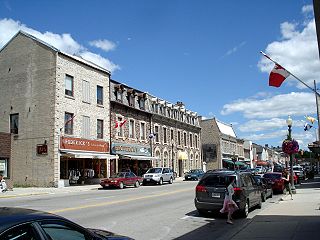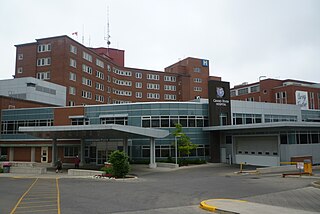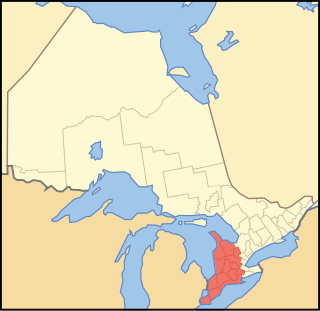Related Research Articles

Guelph is a city in Southwestern Ontario, Canada. Known as The Royal City, it is roughly 22 km (14 mi) east of Kitchener and 70 km (43 mi) west of Downtown Toronto, at the intersection of Highway 6, Highway 7 and Wellington County Road 124. It is the seat of Wellington County, but is politically independent of it.

The Regional Municipality of Waterloo is a metropolitan area of Southern Ontario, Canada. It contains the cities of Cambridge, Kitchener and Waterloo, and the townships of North Dumfries, Wellesley, Wilmot and Woolwich. Kitchener, the largest city, is the seat of government.

Erin is a town in Wellington County, approximately 80 kilometres (50 mi) northwest of Toronto, Ontario, Canada. Erin is bordered by the Town of Caledon, Ontario to the east, the Town of Halton Hills to the south, the Township of Guelph/Eramosa to the west and the Township of East Garafraxa to the north.

Wellington County is a county located in Southwestern Ontario, Canada and is part of the Greater Golden Horseshoe. The county, made up of two towns and five townships, is predominantly rural in nature. However many of the residents in the southern part of the county commute to urban areas such as Guelph, Kitchener, Waterloo, Brampton, Mississauga, Toronto and Hamilton for employment. The northern part of the county is made up of mainly rural farming communities, except for a few larger towns such as Mount Forest and Arthur. According to the 2021 census, the population of the county was 241,026.

The Township of Woolwich is a rural township in Southwestern Ontario, Canada, considered as a municipality. The Township is located in the northeast part of Waterloo Region and is made up of 10 small communities, with Elmira, Ontario the largest and St. Jacobs, Ontario the second largest. The population at the time of the 2021 Census was 26,999, up from the 2016 population of 25,006. Waterloo Region is still home to the largest population of Old Order Mennonites in Canada, particularly in the areas around St Jacobs and Elmira. They are often seen on the local roads using their traditional horse and buggy transportation; many also use horses to pull the implements in their farm fields.

Grand River Hospital is a hospital located in Kitchener, Ontario, Canada. The hospital operates two campuses, Kitchener-Waterloo Health Centre and Freeport Health Centre, which were independent hospitals that merged to form Grand River Hospital in April 1995.

Southwestern Ontario is a secondary region of Southern Ontario in the Canadian province of Ontario. It occupies most of the Ontario Peninsula bounded by Lake Huron, including Georgian Bay, to the north and northwest; the St. Clair River, Lake St. Clair, and Detroit River, to the west; and Lake Erie to the south. To the east, on land, Southwestern Ontario is bounded by Central Ontario and the Golden Horseshoe. The region had a population of 2,583,544 in 2016. It is sometimes further divided into "Midwestern Ontario" covering the eastern half of the area and the heart of Southwestern Ontario encompassing the western half of the region.
Peel Memorial Hospital (PMH) was a 367-bed acute care hospital located in central Brampton, Ontario. PMH was founded in 1925 and became a part of the William Osler Health Centre in 1998. It previously served approximately 400,000 residents in Brampton and the surrounding areas. Over 96,832 patients were treated on an out-patient basis, another 70,446 residents used the 24/7 emergency department and 22,889 patients were admitted for inpatient care. The hospital employed over 1,800 professional and support personnel. There were 320 physicians as well as approximately 600 volunteers that contributed their services and fund raising efforts.
Local Health Integration Networks (LHINs) were the health authorities responsible for regional administration of public healthcare services in the Canadian province of Ontario. Legacy LHIN functions were transferred to the new Ontario Health and the LHIN name was changed to Home and Community Care Support Services.
The Campbellford Memorial Hospital is an Ontario class C and class G 34-bed hospital in the community of Campbellford, municipality of Trent Hills, Northumberland County in central Ontario, Canada. It opened in 1953, is part of the Central East LHIN and is the largest employer in the community. The emergency department had 20,448 visits between April 2009 and Mar 2010
Lakeridge Health is a health system and hospital network serving Durham Region, Ontario in the eastern part of the Greater Toronto Area. It operates four acute hospitals with emergency departments, one specialty hospital with a regional mandate (Whitby) and a variety of offsite locations. Lakeridge Health is part of the Central East Local Health Integration Network.
The Erie St. Clair LHIN is one of fourteen Local Health Integration Networks (LHINs) in the Canadian province of Ontario.
The Central West LHIN is one of fourteen Local Health Integration Networks (LHINs) in the Canadian province of Ontario.
The Mississauga Halton LHIN is a Local Health Integration Network (LHIN) in the Canadian province of Ontario. It is a community-based, non-profit organization funded by the Government of Ontario through the Ministry of Health and Long-Term Care.
The Toronto Central LHIN is one of fourteen Local Health Integration Networks (LHINs) in the Canadian province of Ontario.
Chronic disease in Northern Ontario is a population health problem. The population in Northern Ontario experiences worse outcomes on a number of important health indicators, including higher rates of chronic disease compared to the population in the rest of Ontario.
The North East LHIN is one of fourteen Local Health Integration Networks (LHINs) in the Canadian province of Ontario.
The South East LHIN was one of fourteen Local Health Integration Networks (LHINs) in the Canadian province of Ontario. In 2021, the legacy functions of LHINs were assigned to Ontario Health and the name South East Local Health Integration Network changed to Home and Community Care Support Services South East.
Eatonville Care Centre is a privately owned long-term care facility in the Eatonville area of Etobicoke, Toronto, Ontario, Canada. As of 2020, it is owned by Rykka Care Centres. During the COVID-19 pandemic, it was particularly hard-hit, with 142 resident cases and 40 resident deaths. A report by the Canadian Armed Forces — who had been deployed to the facility, to assist — recorded "aggressive behaviour" by staff and drugging of residents that the Forces deemed unnecessary.
Ontario Health is a Crown agency of the Government of Ontario. Described as a "super agency", Ontario Health oversees much of the administration of the Ontario healthcare system, with the stated goal of integrating services split between organizations.